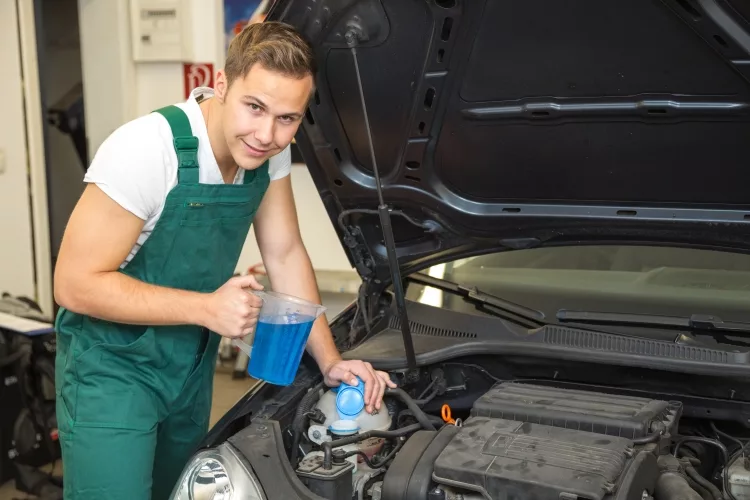How Much Coolant Does a Car Take
by Chris Lewis.
Maintaining the coolant in your car is just as important for your car's health. This article will teach you how to take care of it and what to be aware of when doing so.
How much coolant does a car take? The amount of coolant in your vehicle depends on the make and model. Most vehicles have at least one liter of coolant, but some may require up to ten liters. If you are unsure about how much is in your vehicle, consult with your mechanic or owner's manual before adding any more.
Contents
- A car takes a certain amount of coolant depending on what type it is and how much air flow the vehicle requires
- The most common types of coolant are ethylene glycol, propylene glycol, and water
- Coolant should be changed every two years or sooner if there is an issue with the cooling system
- If you have any questions about your car's cooling system, talk to a mechanic as soon as possible before it becomes too costly to fix.
Coolant reservoir

A coolant reservoir is a container that holds engine coolant, which circulates through the car's radiator. The purpose of this system is to keep the engine at optimum temperature by cooling it down when necessary and heating it up when needed.
If you own a car that is prone to overheating, then it is a good idea to have a coolant reservoir. Many people don't know how to change the coolant in their car because they're not mechanically inclined or worried about damaging their engine.
Fortunately, you can buy one of these reservoirs from many different places and they are fairly inexpensive so if you overheat often, it could be worth your while to get one for yourself.
Top Coolant by Editors
- #PreviewProductRating
- Bestseller No. 1
- Bestseller No. 2
- Bestseller No. 3
- Bestseller No. 4
- Bestseller No. 5
- Bestseller No. 6
- Bestseller No. 7
- Bestseller No. 8
- Bestseller No. 9
- Bestseller No. 10
What is coolant?
Coolant can be a liquid or gas that helps transfer heat away from the engine and into the air. The fluid in your car's radiator is an example of coolant. You should use distilled water as a coolant because it doesn't contain minerals like salt, which can create deposits on engine components and cause corrosion. There are many other types of cooling systems such as air-cooled engines, but they all depend on fluids to maintain their temperatures.
How much coolant does it take to fill a radiator?
Different coolants have different properties, so it is important to know what kind of coolant you are using. Some coolants also use more than one type of additive. The most common types of additives in your radiator's cooling system are rust inhibitors and detergents that keep the engine clean for a long time.
The amount of coolant needed to fill a radiator depends on how much is already in the radiator. If you are just topping off your cooling system, only two cups should be necessary. However, if you need to refill it completely, then 4-5 gallons will do the trick.
It's summer, and your car is starting to overheat. You've heard that you need coolant for this problem, but how much do you use? If it isn't enough, will the radiator overflow? How long does the coolant last before needing to be replaced? These are all questions many people ask themselves when they first notice their car overheating - even if they're not sure what causes it.
How much should you fill your coolant?
On average, you should fill your coolant to the "cold" line on the radiator. However, it is not uncommon for those who live in warmer climates to need more than that as they drive their car more often and for longer distances. The best way to know if you're driving needs a top off is by checking the reservoir tank after you've driven your car around town or taken a long trip. If there's less than an inch of fluid left in there at most, then it's time for another refill.
- Coolant is important for your car's engine
- Your coolant needs to be the right mixture of water and anti-freeze
- When filling your coolant, use a funnel or turkey baster to avoid spills
- A good rule of thumb is about one gallon per every two quarts in your engine
- Check with your owner's manual for specific instructions on how much you need to fill up
- If you're not sure if you have enough, add more until it starts leaking out from under the hood
You should fill it until the liquid is visible in between the threads of your radiator.
What happens if coolant is above max?
Your car's engine is made up of many components, but all of these parts work together to keep your engine running smoothly. One particularly important component is the coolant, which helps regulate the temperature inside an overheating vehicle. The coolant also absorbs heat from the combustion process and carries it away from hot surfaces in order to help maintain a balance between high-temperature fluids (like oil) and coolant. If your vehicle becomes too warm or if you notice that your exterior temps are getting hotter than normal, then it could be due to one of two issues: either there may not be enough antifreeze in the reservoir or there may be an issue with your cooling system (such as a blown head gasket). With this post.
If the coolant is too high in the radiator, it can cause damage to your car's engine over time.
Conclusion for Coolant Buyers
If you have a car, chances are it has one of two types of coolant systems. The first type is an older style system that uses a radiator to pump the liquid through the engine and back out again. This type needs a 50/50 mix of water and antifreeze which can be found at any auto parts store for under $20. The second type is newer, with an internal or external heat exchanger that pumps fluid from inside the vehicle into small tubes on top of the engine block where it heats up before being pushed back down by fans. These cars require special coolant called Dex-Cool (available in pink) which costs around $22 per gallon plus disposal fees if your car isn't equipped with recycling.
 |
 |
 |
 |

About Chris Lewis.
Chris Lewis is a passionate individual with a deep affinity for the world of automobiles. From a tender age, his fascination with cars was nurtured by his father, a seasoned mechanic based in the vibrant city of San Francisco. Growing up under the watchful guidance of his skilled father, Chris developed an early aptitude for all things automotive.
Thoughts on "How Much Coolant Does a Car Take"
 |
 |
 |
 |
Get FREE Filters now. Or latest free tools from our best collections.
Disable Ad block to get all the secrets. Once done, hit any button below
 |
 |
 |
 |









